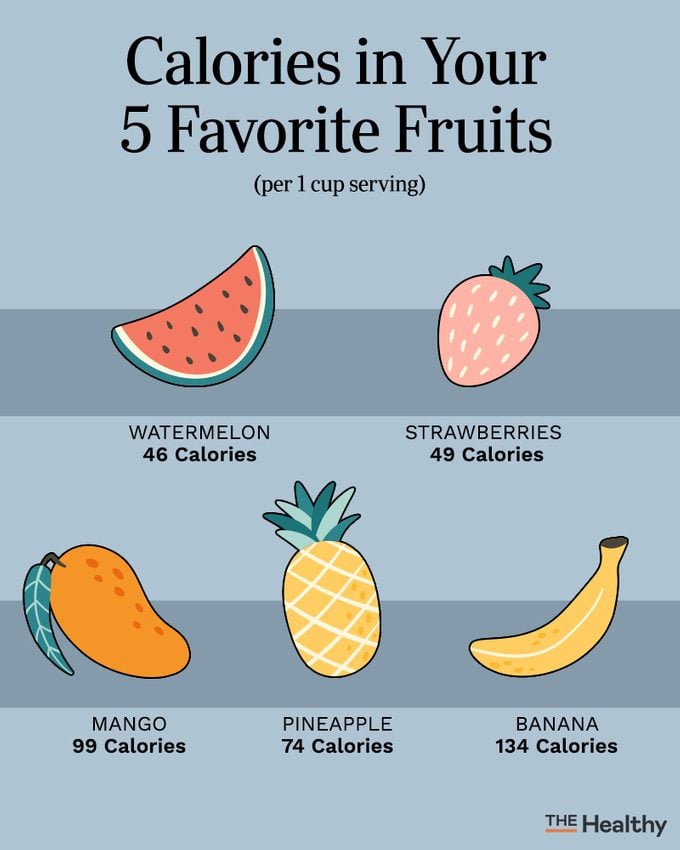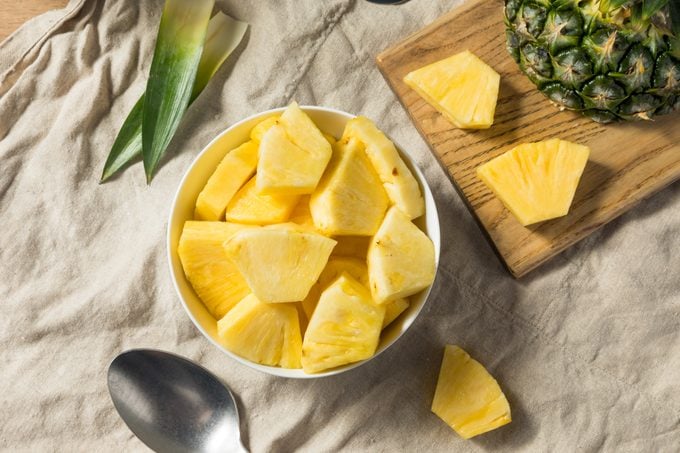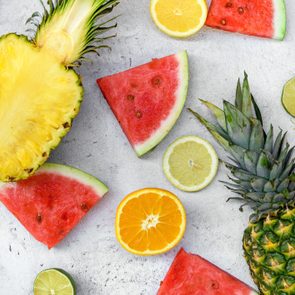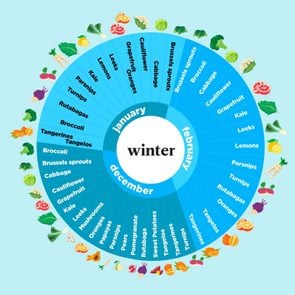Are Pineapples High in Calories? Here’s What RDs Want You to Know
Updated: Mar. 14, 2022
Pineapple is a sweet, low-fat fruit that can be a part of a healthy diet. Learn about the calories in pineapple, its nutrition, benefits, and how to eat it.
Our editors and experts handpick every product we feature. We may earn a commission from your purchases.
The sweetness of pineapples
Pineapple is known for its complex spikey texture on the outside and its characteristic sweetness on the inside.
It’s because of this notable sweetness that the health-conscious often wonder whether it can be a part of a healthy diet. The short answer is yes.
Pineapple is filled with vitamins and minerals and is low in fat and sodium.
Read on to learn more about the calories in pineapple, the beneficial nutrients it contains, and how to select the perfect pineapple no matter what recipe you are making.
Where does pineapple come from?
Pineapple, which originated in South America, is considered the third most important tropical fruit in the world, following bananas and citrus.
It actually got its name from European explorers who thought the fruit looked like a pine cone.
Today, the majority of fresh pineapples are grown in Costa Rica, Brazil, and the Philippines, according to market and consumer data company Statista.
Pineapple nutrition facts
You know pineapple packs a wallop of sweetness with a little tang, but what does it offer nutritionally? A good deal of vitamins, for one thing.
Here are the nutrients in one cup (165 grams) of raw pineapple chunks:
Calories: 74
Protein: 1 g (2 percent of the daily recommended value, or DV)
Fat: 0 g (0 percent DV)
Sodium: 2 mg (0.08 percent DV)
Carbohydrates: 19.5 g (7 percent DV)
Fiber: 2 g (7 percent DV)
Vitamin D: 0 ug (0 percent)
Vitamin C: 28 mg (31 percent DV)
Iron: 0.41 mg (2 percent DV)
Potassium: 206 mg (4 percent DV)

Pineapple calories vs. other fruits
Due to its sweetness, pineapple is often thought of as a high-calorie fruit, but is that accurate?
There are 74 calories in a cup of pineapple, with the majority coming from carbohydrates.
When compared to a similar serving size of other fruits, the calories in pineapple fall right in the middle.
For comparison, watermelon and strawberries contain 46 and 49 calories respectively, whereas a cup of sliced mangoes contains 99 calories. And a banana has 134 calories per cup.
But it is important to keep in mind that calories are not the only measurement you should look at when determining a food’s nutrient value.
“While the comparison provides some insight into calories, it’s important to consider the nutritional value and serving size of each fruit,” explains registered dietitian Kelsey Pezzuti.
(Here’s how the calorie content in food is determined.)
Benefits of pineapple
Pineapple is more than just a delicious, colorful fruit. Its rich nutrient profile can offer health benefits.
Boosts immune system
“One cup of pineapple chunks offers an excellent source of vitamin C, which not only improves your immune system but also assists the body in forming collagen, a vital contributor to wound healing,” explains Pezzuti.
Keeps bone healthy
It’s not just your immune system that can benefit from adding pineapple to your plate. One cup of this juicy fruit provides an excellent source of manganese, a nutrient that plays a key role in the health of bones and tissue.
“Eating a few chunks of pineapple a day can help prevent bone loss in patients with osteoporosis,” adds Pezzuti.
Aids digestion
Perhaps the most beneficial compound found in pineapple hides in its stem.
“While pineapple has numerous health-boosting micronutrients, what makes them truly exceptional is their ability to help with digestion, boost immunity, and fight cancer with a group of enzymes, found in the fruit and stem of the fruit, known as bromelain,” explains Arielle Dani Lebovitz, a registered dietitian nutritionist and certified diabetes care and education specialist.
And thanks to the fiber within pineapple, the benefits of bromelain may go even further.
“This protein-digesting enzyme may help ease digestion for those with inflammatory bowel disease by reducing inflammation in the gastrointestinal tract, and when you combine these enzymes with fiber, they work as a team to encourage optimal digestion,” says Pezzuti.
Downsides of pineapple
Generally speaking, most people can enjoy pineapple. But there are certain times when you may want to eat it in moderation.
It makes your mouth burn
If you’ve eaten pineapple, there’s a good chance you know the feeling of a pineapple-related mouth burn. Eat too much of the fruit, and you could get a sore, burning tongue or raw spots on the corners of your mouth.
You have bromelain to thank for that. The enzyme dissolves the protective coating of mucus in your mouth, which can lead to irritation.
One way to sidestep this unpleasant side effect is to eat pineapple in moderation.
It’s higher in carbs
Although the nutrients found within pineapple may offer health benefits, people with diabetes are often told to avoid this sweet fruit due to its sugar content. But that advice may be unfounded.
“All fruits can fit into a healthy way of eating,” says Vandana Sheth, a certified diabetes care and education specialist and author of My Indian Table: Quick & Tasty Vegetarian Recipes.
She suggests pairing pineapple with a source of protein or plant-based fat, such as nuts or cottage cheese, to prevent a spike in blood sugar.
And simply adjusting your portion size may be all you need to do to fit pineapple into your diabetes meal plan.
“If you need to watch your carbohydrate intake, you can easily turn pineapple into a lower-carbohydrate fruit just by cutting the serving size in half,” adds Pezzuti.

How to pick a good pineapple
Now that you have decided to add pineapple to your plate, it is time to shop for the fruit. Start by identifying what a ripe pineapple looks and feels like.
“To pick the perfect pineapple, choose one that is green to yellow-gold, plump, and firm with fresh green leaves that feel heavy for their size and have a sweet aroma,” says Lebovitz, who is also author of Where Do Bananas Come From?
Making sure you pick a ripe fruit is especially critical for pineapple.
“Once picked, pineapples do not continue to ripen or sweeten; they only get juicier. This means that if pineapples are picked before they are ripe, they will never be sweet,” Lebovitz says.
If you want to save time, you may consider purchasing canned pineapple as an alternative to fresh as a done-for-you option.
If you go this route, keep one important detail in mind: Select canned pineapple packed in its own juice—not syrup.
“Look for descriptions on the label like ‘packed in 100 percent juice’ or ‘no added sugar’ since fruit packed in juice contains less added sugar than fruits packed in syrup,” explains Pezzuti.
If you need inspiration for cooking with canned pineapple, try one of these canned pineapple recipes.
(Check out this guide to seasonal fruits and vegetables.)
The best ways to enjoy pineapple
Fresh, sliced pineapple is delicious on its own, but it isn’t the only way this fruit can be enjoyed.
“Try grilling pineapple and serving alongside ice cream or pairing with chopped nuts for dessert,” shares Sheth. (Bonus: the act of grilling will make the fruit less likely to burn your tongue.)
You can also pair this sweet fruit with savory dishes.
“Mix a can of crushed pineapple with guacamole for a fiber-filled dip, or use as a taco mix-in or burger topping,” adds Pezzuti.
To gain the benefit of all the pineapple, make sure to include the core as well. “You can save the core and freeze it, then add it into smoothies to increase the fiber and sweetness,” shares Lebovitz.
If you are looking to try out a few new pineapple recipes, take a look at this list of the 50 greatest pineapple recipes. You just may discover your new favorite dish.





















